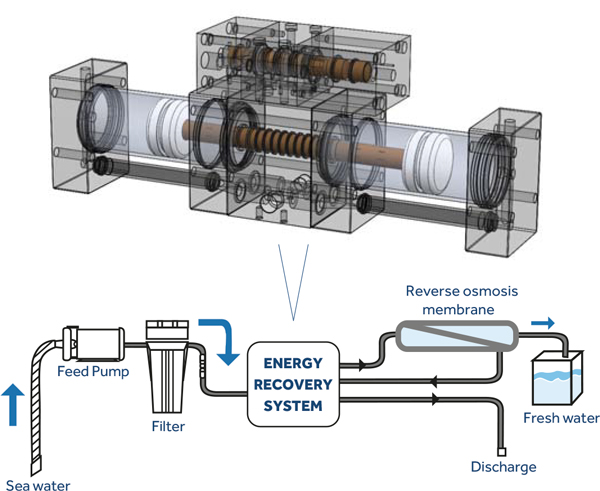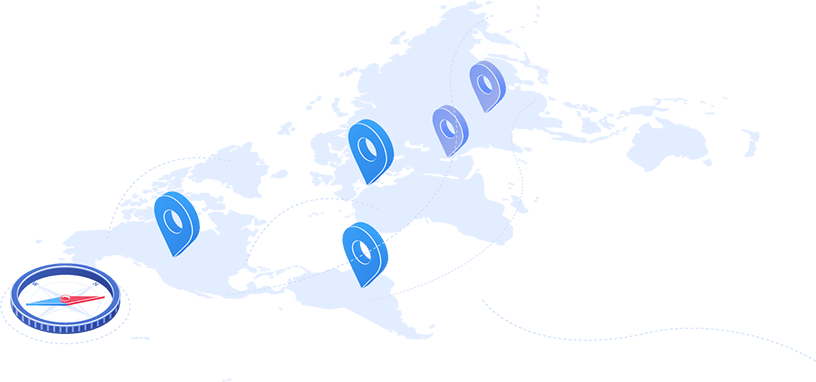Schenker technology
Schenker uses a low-pressure feed pump. The pressure is then increased using its new, patented Energy Recovery System powered by the waste water from the reverse osmosis process. This results in very high-energy eficiency with typical power consumption of only 4 Watts per litre of drinking water produced.

The Schenker watermaker price is, on average, less than a traditional system and is certainly a lot cheaper to run.
The technology is more reliable than that of traditional watermakers as it doesn’t use high pressure pumps, which are the main cause of failures and maintenance problems. Schenker Watermakers all carry a 3-year guarantee.
The consumed energy is up to 80% lower than a traditional system. A Schenker watermaker can be powered directly from the vessel’s service batteries. A Schenker watermaker, is easy to use. It does not require adjustments, is totally silent and vibration-free.
They are watermakers based on a new functioning principle that removes the need for high pressure pumps, which were used traditionally.
Traditionally a yacht is restricted in time & distance to the amount of fresh water carried in its tanks. Thanks to a watermaker an unlimited quantity of water can be produced increasing both time and distances achievable between harbours. The comfort of unlimited showers and freshwater improves life onboard. Racing crews don’t need to carry volumes of water that may affect performance.
A Schenker watermaker produces very high quality fresh, drinkable water. The average residual salt is about 300 parts per million, similar to a good quality bottled mineral water.
How to choose the right watermaker
Good question. All Schenker wtermakers are fitted with an Energy Recovery System, and the electric consumption is very low for both DC and AC systems.
Smaller units, fon instance 30 and 50 lit./h are available DC only. The power required is so low that it makes no sense to consider AC power.
For bigger system, from 60 to 150 lit./h, both DC and AC power supply are available.
If the boat is not fitted with a generator, the choice will be DC, of course.
If a generator is available but used rarely, the DC will be the better choice as well, whereas AC is recommended if the generator is used extensively. Even for an AC system, the low power consumption is great advantage as it reduces the amount of load on the generator.
The ideal watermaker should provide the daily fresh water needs of the boat in about 3-4 working hours.
The daily fresh water demand is based on the number of people onboard and the type of boat. Typical fresh powerboat or catamaran. For instance on a sailing boat with a crew of 5 people the estimated daily fresh water need is 150 – 200 lit.
Therefore the ideal watermaker capacity is 50 – 60 lit./h
Schenker watermakers are available in 3 models, Zen, Smart and Modular.
All units are fitted with an Energy Recovery System, reducing electric consumption to a minimum.
Materials, quality and reliability of the 3 models are equivalent.
In the Zen basically all components are integrated in the main manifolds, and there are very few external components such as fittings, hoses & valves. This make the Zen very compact, with a special ultra-flat design.
On the contrary, the Smart and Modular family are based on a more traditional configuration, therefore the main components of the watermaker (ERS, membranes, valves, pipes) are separated, making the inspection and service of the parts very simple.
The Smart is mainly based on single, long membranes whereas the Modular makes use of split membranes. Therefore the external dimensions of the 2 machines are quite available.
Finally the Zen is available with a Basic remote control panel (this allows remote start/stop, flushing and timing options) whereas the Smart and Modular family are available with 3 different control options: Basic, Analogic and Digital.
Whether you own a sailboat or a yacht or any other kind of vessel its irrelevant. You should instead evaluate this: the liters of fresh water you need daily and to choose the right power system between AC or DC.
Voltage of Schenker desalinators is always very low thanks to our patented Energy Recovery System. Nevertheless bigger units (60-150 lit/h) would need 24 volt. The right question is therefore “How much drinkable water do I need?”. Keep also in mind whether a power generator is present or not on your vessel.
The ideal watermaker should provide the daily drinkable water needs of the boat in about 3-4 working hours.
The daily fresh water demand is based on the number of people onboard and the type of boat. Typical fresh powerboat or catamaran. For instance on a sailing boat with a crew of 5 people the estimated daily drinkable water need is 150-200 lit.
Therefore the ideal watermaker capacity is 50-60 lit./h
After purchase: Functioning
Even with a generator fitted to the boat, the new generation Schenker watermaker gives working flexibility. Why run the generator just to power a watermaker?
Assuming that a 60 litre watermaker system works 3 hours a day, the consumed energy is 20 Ahx3h = 60A. With a 80A alternator, the consumed energy is recharged in 45 minutes by the engine.
Yes it can. It all depends on the capacity of the service batteries. Assuming that the service batteries capacity is 300 Ah and a Schenker 60 l / h system consumes 20 Ah at 12 volt, the calculation is 300 / 20 = 15 hours. In reality the watermaker wont be used for this length of time.
To install a Schenker watermaker is easy because the seawater intake is Tee’d from an existing outlet. It can be installed when the boat is in the water. The installation can be carried out by a shipyard or by a Schenker Assistance Centre. Its average cost is about 800-1000 Euro. You can also install it yourself. Just follow the instructions in the operation and maintenance manual.
After purchase: Maintenance and Support
A list of Schenker Service points is continuously updated on “Dealers” page. A service telephone number is also available to give assistance. Spare parts can be sent directly to your boat if area is not covered by dealers/distributors.
The only consumable that must be replaced periodically (on average 1 or 2 times in a season) is the pre filter cartridge, which is inexpensive. The reverse osmosis membrane is expensive to replace but has an average life of 6-7 years if the maintenance manual instructions are carefully followed.
Maintenance is very easy. Watermakers like to be used regularly. If left standing for 10 to 15 days they will need flushing through. This operation can be performed automatically with electronic control or manually. During long standstills it will be necessary to flush the watermaker with biocide to avoid growth forming in the membrane.


